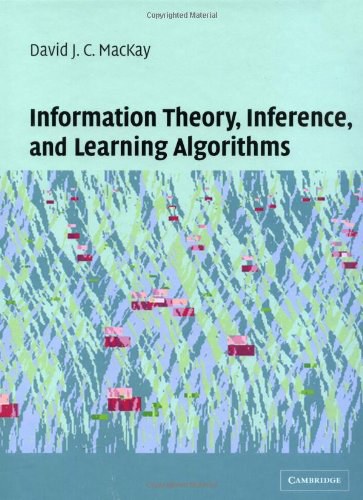
书名:Information Theory, Inference and Learning Algorithms
作者:DavidJ.C.MacKay
译者:
ISBN:9780521642989
出版社:CambridgeUniversityPress
出版时间:2003-10-6
格式:epub/mobi/azw3/pdf
页数:640
豆瓣评分: 9.3
书籍简介:
Information theory and inference, taught together in this exciting textbook, lie at the heart of many important areas of modern technology – communication, signal processing, data mining, machine learning, pattern recognition, computational neuroscience, bioinformatics and cryptography. The book introduces theory in tandem with applications. Information theory is taught alongside practical communication systems such as arithmetic coding for data compression and sparse-graph codes for error-correction. Inference techniques, including message-passing algorithms, Monte Carlo methods and variational approximations, are developed alongside applications to clustering, convolutional codes, independent component analysis, and neural networks. Uniquely, the book covers state-of-the-art error-correcting codes, including low-density-parity-check codes, turbo codes, and digital fountain codes – the twenty-first-century standards for satellite communications, disk drives, and data broadcast. Richly illustrated, filled with worked examples and over 400 exercises, some with detailed solutions, the book is ideal for self-learning, and for undergraduate or graduate courses. It also provides an unparalleled entry point for professionals in areas as diverse as computational biology, financial engineering and machine learning.
作者简介:
Sir David John Cameron MacKay FRS FInstP FICE (22 April 1967 – 14 April 2016) was a British physicist, mathematician, and academic. He was the Regius Professor of Engineering in the Department of Engineering at the University of Cambridge and from 2009 to 2014 was Chief Scientific Adviser to the UK Department of Energy and Climate Change (DECC). MacKay authored the book Sustainable Energy – Without the Hot Air.
书友短评:
@ Mo 图文并茂,但是有点废话太多,数学不严谨。 @ 蝉 : G 好书好书太多了,还要继续读第三遍 @ Loch~ “ this exciting textbook”….才知道MacKay去世了,可惜啊。 @ 水如歌 机器学习领域中的 Feynman。 @ Rosetta 需要买一本 反复查阅 @ Abacus 很清晰简明的信息论教程,非常适合初学者的学习 @ 润Rhuen 一半弃读 @ δεζη (读过部分章节)与很多教材不同的是,把很多东西放在一起讨论,很有意思。适合做个补充类读物。要是学信息论或者机器学习还是以其他教材为主吧
1 Introduction to Information Theory
2 Probability, Entropy, and Inference
3 More about Inference
Part I Data Compression
4 The Source Coding Theorem
5 Symbol Codes
6 Stream Codes
7 Codes for Integers
Part II Noisy-Channel Coding
8 Dependent Random Variables
9 Communication over a Noisy Channel
10 The Noisy-Channel Coding Theorem
11 Error-Correcting Codes and Real Channels
Part III Further Topics in Information Theory
12 Hash Codes: Codes for Efficient Information Retrieval
13 Binary Codes
14 Very Good Linear Codes Exist
15 Further Exercises on Information Theory
16 Message Passing
17 Communication over Constrained Noiseless Channels
18 Crosswords and Codebreaking
19 Why have Sex? Information Acquisition and Evolution
Part IV Probabilities and Inference
20 An Example Inference Task: Clustering
21 Exact Inference by Complete Enumeration
22 Maximum Likelihood and Clustering
23 Useful Probability Distributions
24 Exact Marginalization
25 Exact Marginalization in Trellises
26 Exact Marginalization in Graphs
27 Laplace's Method
28 Model Comparison and Occam's Razor
29 Monte Carlo Methods
30 Efficient Monte Carlo Methods
31 Ising Models
32 Exact Monte Carlo Sampling
33 Variational Methods
34 Independent Component Analysis and Latent Variable Modelling
35 Random Inference Topics
36 Decision Theory
37 Bayesian Inference and Sampling Theory
Part V Neural networks
38 Introduction to Neural Networks
39 The Single Neuron as a Classifier
40 Capacity of a Single Neuron
41 Learning as Inference
42 Hopfield Networks
43 Boltzmann Machines
44 Supervised Learning in Multilayer Networks
45 Gaussian Processes
46 Deconvolution
Part VI Sparse Graph Codes
47 Low-Density Parity-Check Codes
48 Convolutional Codes and Turbo Codes
49 Repeat-Accumulate Codes
50 Digital Fountain Codes
Part VII Appendices
Notation; Some Physics; Some Mathematics
· · · · · ·
添加微信公众号:好书天下获取
 好书天下
好书天下
评论前必须登录!
注册